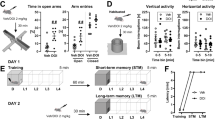Abstract
This preclinical study examined the psychological processes affected by amphetamine that contribute to human psychosis. Using a novel avoidance conditioning paradigm involving two conditioned stimuli (CS) with varied salience, we found that acute amphetamine (1.5 mg/kg, i.p.) selectively enhanced avoidance responding to a less salient stimulus, but not to a salient one. These findings suggest that elevated dopaminergic activity selectively enhances the attributions of motivational salience to a less salient stimulus, a process that may bear relevance to the development of human delusional thoughts.


Similar content being viewed by others
References
Beninger RJ (2006) Dopamine and incentive learning: a framework for considering antipsychotic medication effects. Neurotox Res 10:199–209
Berridge KC, Robinson TE (1998) What is the role of dopamine in reward: hedonic impact, reward learning, or incentive salience? Brain Res Brain Res Rev 28:309–369
Buchanan RW, Davis M, Goff D, Green MF, Keefe RS, Leon AC et al (2005) A summary of the FDA-NIMH-MATRICS workshop on clinical trial design for neurocognitive drugs for schizophrenia. Schizophr Bull 31:5–19
Castner SA, Vosler PS, Goldman-Rakic PS (2005) Amphetamine sensitization impairs cognition and reduces dopamine turnover in primate prefrontal cortex. Biol Psychiatry 57:743–751
Gray JA (1998) Integrating schizophrenia. Schizophr Bull 24:249–266
Hemsley DR (1993) A simple (or simplistic?) cognitive model for schizophrenia. Behav Res Ther 31:633–645
Jones SH, Hemsley DR, Gray JA (1991) Contextual effects on choice reaction time and accuracy in acute and chronic schizophrenics. Impairment in selective attention or in the influence of prior learning? Br J Psychiatry 159:415–421
Kapur S (2003) Psychosis as a state of aberrant salience: a framework linking biology, phenomenology, and pharmacology in schizophrenia. Am J Psychiatry 160:13–23
Killcross AS, Dickinson A, Robbins TW (1994) Amphetamine-induced disruptions of latent inhibition are reinforcer mediated: implications for animal models of schizophrenic attentional dysfunction. Psychopharmacology (Berl) 115:185–195
Li M, Fletcher PJ, Kapur S (2007) Time course of the antipsychotic effect and the underlying behavioral mechanisms. Neuropsychopharmacology 32:263–272
Norman C, Cassaday HJ (2003) Amphetamine increases aversive conditioning to diffuse contextual stimuli and to a discrete trace stimulus when conditioned at higher footshock intensity. J Psychopharmacol 17:67–76
O’Tuathaigh CM, Salum C, Young AM, Pickering AD, Joseph MH, Moran PM (2003) The effect of amphetamine on Kamin blocking and overshadowing. Behav Pharmacol 14:315–322
Robinson TE, Becker JB (1986) Enduring changes in brain and behavior produced by chronic amphetamine administration: a review and evaluation of animal models of amphetamine psychosis. Brain Res 396:157–198
Swerdlow NR, Braff DL, Geyer MA (2000) Animal models of deficient sensorimotor gating: what we know, what we think we know, and what we hope to know soon. Behav Pharmacol 11:185–204
Weiner I (2003) The “two-headed” latent inhibition model of schizophrenia: modeling positive and negative symptoms and their treatment. Psychopharmacology (Berl) 169:257–297
Wise RA (2004) Dopamine, learning and motivation. Nat Rev Neurosci 5:483–494
Wyvell CL, Berridge KC (2001) Incentive sensitization by previous amphetamine exposure: increased cue-triggered “wanting” for sucrose reward. J Neurosci 21:7831–7840
Acknowledgments
This study was funded in part by a support from the Nebraska Tobacco Settlement Biomedical Research Development Funds, and UNL Layman Award to ML.
Author information
Authors and Affiliations
Corresponding author
Rights and permissions
About this article
Cite this article
Li, M., He, W. & Munro, R. Amphetamine selectively enhances avoidance responding to a less salient stimulus in rats. J Neural Transm 115, 773–776 (2008). https://doi.org/10.1007/s00702-007-0002-7
Received:
Accepted:
Published:
Issue Date:
DOI: https://doi.org/10.1007/s00702-007-0002-7




